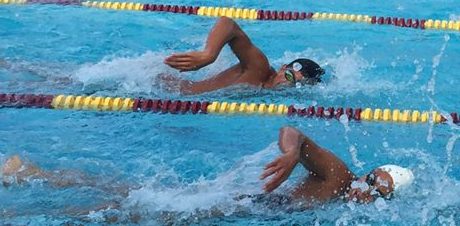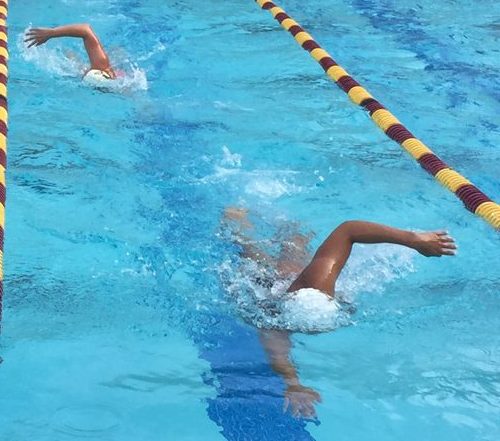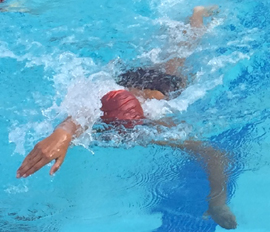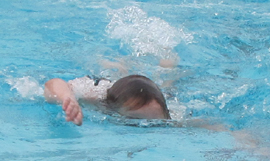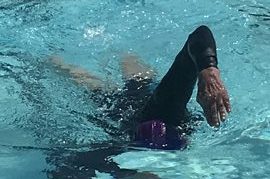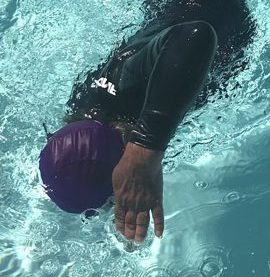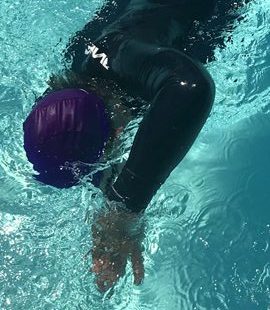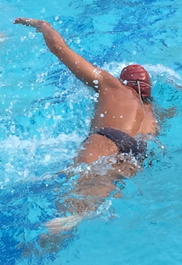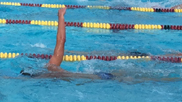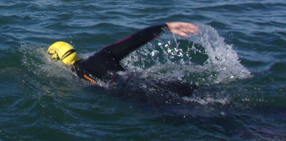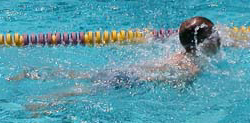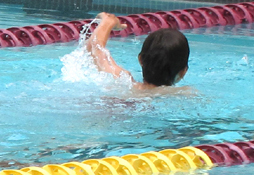At the Red Cross swim teacher certification page, you can watch a video of Front Crawl (another name for freestyle), the fastest swim stroke. This video has more details than you can absorb in one viewing. My students who have seen it during classes multiple quarters in a row say they noticed something new each time. It can give you an introduction to the stroke, and/or new things to try, especially if you are already an accomplished swimmer.
To find the video go to
https://www.redcrosslearningcenter.org/s/candidate-water-safety
scroll down to the Videos section and click on Swimming and Diving Skills: Front Crawl (it runs just under seven minutes).
If you use Firefox as your browser, you get an error message: “No video with supported format and MIME type found.”
Google Chrome and Microsoft Edge work as browsers.
I also offer a transcript of the video for review.
You can also find backstroke, titled “Back Crawl”
as well as Breaststroke, Butterfly, Elementary Backstroke and Sidestroke, as well as other swimming skills.
In this webpage, where there are quotes from the Red Cross about how to swim freestyle, most of the quotes are from American Red Cross Swimming and Water Safety Manual. There is a link to it near the end of this webpage.
Many people do not know they are swimming incorrectly and do not know what great swimming strokes should look like.
Watching the video and taking a look at these pictures should give you a good idea of what you should be doing and what you should be seeing in others if you give feedback.
Some of the notes and photos below show common mistakes with freestyle swimming to help make you better able to observe other swimmers in your group and help them correct issues with their swimming and gives tricks to prevent or cure common mistakes.
Here is a brief, simplified description of the arm motion for freestyle swimming.
The “pull” is the power part of the stroke, it starts when your arm is fully extended out in front of you. You start bending your arm and “pull” (push) the water towards your feet, with about a 90 to 100 degree elbow bend about half way through the “pull,” and finishing with your arm fully extended at your side.
At the end of your underwater “pull”, when your arm is fully extended at your side, you begin your “recovery,” (to bring your arm in the air back towards the front of your body to be ready to start another pull), by lifting your elbow out of the water first (her left arm below)
Your elbow should stay higher than the rest of your arm as your arm swings around in the air, staying out of the water the entire time of the “recovery.”
The Red Cross gives this description of your hand entering the water (see photos below):
“Keep the elbow partly flexed so that the point of entry is about three-fourths as far as the arm could reach if straight. Allow the hand to enter the water smoothly, keeping the elbow higher than the rest of the arm. The elbow enters the water last. Think of this part of the stroke as the forearm going through a hole that the hand makes in the water’s surface. The hands should be relaxed with the fingertips straight.”
You are trying to have your hand, then your arm, slide into the water
without pushing any water in the wrong direction.
Your elbow should still be high as your fingertips enter the water,
then stretch out underwater as far as possible in front of you, (her right arm below)
then start pulling (pushing) the water towards your feet.
Common mistakes happen often with the hand/arm as it enters the water. Many freestyle swimmers do get their arm fully out of the water, but let their elbow drop before their hand enters the water. In the next 2 photos you can see the hand, but the arm is already in the water:
and in this photo the elbow is dropped and the head is too high.
People should not see your forehead / eyebrows as you swim towards them:
This swimmer has extended his arm fully out in front of him before his arm hits the water:
This swimmer is just about to let her elbow drop, and to try to get her fingertips in the water first, has bent her wrist. This is very common, even in experienced swimmers.
Many swimmers are not aware they make these mistakes and can benefit
from a partner who knows what to look for watching them and giving them feedback
Swimmers can often correct their elbow dropping too soon
by trying to enter the water with their elbow very bent and high out of the water,
and fingers – then wrist – then forearm – enter right next to the side of their head
instead of about three-fourths as far as their arm could reach if straight.
A partner watching, who knows what to look for, can tell a swimmer trying this
if they are successful in exaggerating the entry point right next to their head
OR when they succeed by entering where they should be
(about three-fourths as far as their arm could reach if straight).
– – – – – – – – – – – – – – – – – – – – – – – – – – – – – – – – – – – – – – – – – – – – – – – – – – – – – – – – – –
A common mistake is to not lift your arm high enough out of the water, and many novice and beginning swimmers make this mistake. Some people first learning to swim or relearning to swim, can’t consistently get their arms fully up out of the water, but with time and effort can do so.
– – – – – – – – – – – – – – – – – – – – – – – – – – – – – – – – – – – – – – – – – – – – – – – – – – – – – – – – – –
Another common mistake is to lift your arms higher than needed in a pool.
(Your bent elbow should always be much higher than your forearm, and your fingertips should almost be dragging along the pool surface).
In a swimming pool the lane lines are designed to make the water less choppy and even advertised to make pools “faster.”
But during open water swims most swimmers lift their arms well out of the water so they don’t keep hitting the small waves / choppy water with their arms. But some of these people swimming in races in San Francisco bay seem to be lifting their arms higher they they need to:
In anticipation of an open swim / triathlon you could do some laps trying to just get your arms a little higher out of the water.
This is another practice that you can have another swim class member watch and give you feedback.
A more effective pull means it take fewer pulls to cover a given distance. My swim students take 8 for very advanced swimmers, to 14 to over 40 pulls to get across the 25 yard width of the pool. (One beginning class noted in their swim journal, 30 to 22 pulls.) They need more pulls when they are trying to go faster, fewer when they are swimming at a slow pace, because at a slower pace they glide a little longer with each pull. Olympic champion Katie Ledecky usually needs 38 to 39 strokes to swim the 50 meter length of an Olympic-sized pool.
Until you can get your arms consistently out of the water during the recovery
and keep your elbow higher than the rest of your arm on your recovery and entry,
breathing to the side will likely not work well.
USMS (United States Masters Swim) reminds us:
“Your movements might be wrong,
but they’re embedded in your neurological pathways nonetheless.
Rewriting some of the code takes time and repetition.”
When breathing in during the freestyle stroke, to be a fast swimmer
the timing of your breathing,
arm position
and head position
are critical.
All your exhaling needs to take place while your face is in the water, as you will not have enough time when you turn your face out of the water to take a deep breath in AND do any exhaling. Most people exhale from their mouth with their lips pursed, some exhale from both their mouth and nose.
You should practice blowing at least some of the air out your nose to get in the habit so you can more easily exhale through your nose during a flip turn or during a backstroke start and not get lots of water up into your sinuses.
Most people learn to control the rate that they exhale. (Pursing your lips can help with this.) They do not breathe out forcefully and quickly, but instead breathe out at a slow or moderate rate that makes the exhaling last the entire time until just before the next breath in. Then they inhale quickly and deeply. You can practice this while just standing in the pool, but be sure to not breathe rapidly and deeply multiple times and hyperventilate.
At swim class safety rules we read: “Don’t hyperventilate (rapid, multiple deep breaths) before attempting to swim a distance. Many people think that hyperventilation can increase their oxygen stores but it does not. Instead it decreases your carbon dioxide levels in your bloodstream, the main clue that tells your brain you need to get a breath. You can pass out underwater, leading to inhalation of water, heart arrest and or heart damage and possibly death.” (We will talk about the dangers of hyperventilating in class.)
Don’t worry about trying to exhale completely out,
having some air still in your lungs is more comfortable.
For most people the first way they learn is to breathe in when their head is turned to the right, if they are right-handed, on the left if they are left-handed. But eventually being able to breathe to both sides is useful.
Breathing has a choice of patterns.
2 count breathing is when you breathe in on one arm pull and exhale while the other arm pulls. For most swimming this can be too much air (and breathing more often slows you down).
4 count breathing is when you breathe in on one arm pull and exhale for the next three pulls, for example, inhale while the right arm pulls and exhale as the left arm pulls, the right arm pulls again and the left arm pulls again. For most swimming this can be just enough air, or you can switch back and forth between 2 and 4 count breathing as needed.
3 count (bilateral) breathing is when you breathe in during one arm pull on one side of your body, and exhale for the next two pulls, then breathe in on the other side of your body. This can often be just the right amount of air for long distances and you can take a look at people in the lanes on both sides of you that you might be racing against. (Advice from United States Masters Swimming on why and how open water swimmers can learn to breathe bi-laterally.)
As you become more proficient you may be able to breathe occasionally in a 6 count or (even larger number) pattern: breathe in on one arm pull and exhale slowly for the next five arm pulls.
Your breath in should be timed for just about the end of your underwater pull. As your arm pulls underwater under you, when it is at about half way through the pull, you should start to turn your head to the side. If you tap your fingers on the side of your leg at the end of your pull, that is when you should be breathing in (maybe a little later, maybe a little before).
This woman below is breathing in very late, a common mistake.
I have had students who learned to breathe in after their arm comes out of the water and have done their breathing like this pictured below for years. Correcting the timing of your breath in, (to have finished a breath in, and have your face back in the water before your arm is at this point)
can take a lot of work, but students exclaim how much easier it is when they are able to fix their timing.
You need to learn to only turn your head towards the side, but not lift it out of the water when you breathe in. If your head stays in the water, turning to the side and not lifting out of the water, it will make a “wake” like when a boat goes through the water.
It will push water out of the way and the water level right next to your mouth as you turn and breathe in will be lower than anywhere else in the pool.
Even once you are quite used to breathing in properly, sometimes the timing is a little off, or the water is across your mouth as you turn to breathe, so you do not find an air pocket, so you do not breathe in on that moment, but wait until the next opportunity.
Another common, normal issue can come when you are concentrating on your arm pull and your flutter kick stops functioning. When people are first learning to swim they might end up with no flutter kick, but with their legs moving in a climbing stairs or riding a bicycle movement, because their brain is more used to that movement and does it with out consciously thinking. Many find that when they are thinking about parts of their arm pull, they forget to kick at all. One way to help prevent this is, as you leave the side of the pool, always start your kick first, then add your arm pull.
It is easier to just lift your head up out of the water, and when people first learn freestyle swimming, they often breathe in with their head lifted instead of just turning their head to the side.
These young swimmers below are actually triathletes and can swim for many laps with this improper breathing technique, but again, they will never be fast. When you lift your head up it makes your legs sink and creates drag, slowing you down, plus your arm pull is not as effective.
Many adults who join my college swim classes also breathe by lifting their heads up out of the water,
or turning their face to look up towards the sky / ceiling,
or by rolling over almost on to their back.
Most do not realize they are breathing improperly and some have even been told they were doing it correctly.

One clue you can use to see if you are lifting your head is to notice if you see water through the bottom lens of your goggle at the moment you breathe in. If your head is not fully enough in the water, you will not see water. You can also have a member of your group swimming near each other watch you breathe and give you feedback.
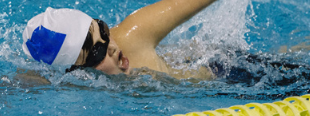
Take a look at these two swimmers again. They are either inhaling at this moment or have just finished inhaling and are turning their heads back into the water. It might look like they can’t be getting any air, but their heads in the water are making a “wake”, and they are getting air each time they turn and breathe in like this.
And these two, seen coming at the camera, are breathing in at this moment (or have just finished breathing in).
You can see the “wake” their heads in the water make,
again, making the water level right next to their faces lower than anywhere else in the pool.
(Seen in a 1932 photo above) Duke Paoa Kahinu Mokoe Hulikohola Kahanamoku
won Olympic gold medals, swimming with his head partially up to breathe.
One of his world record 100 yard freestyle swims was timed at 55.4 seconds.
Current men’s USMS records are almost down to 40 seconds, and women’s records are in the 48 second range.
Swimming with your head up out of the water
can be something you want to do occasionally on purpose,
to get the muscles developed to be able to do it,
for example, when in an open-water swim, looking up to sight around a turn
or try to sight on that race lead boat with the big red bouy to follow:
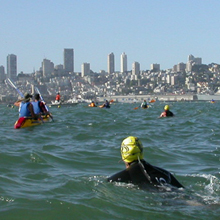
or to be better able to play water polo,
since most of the swimming you use in water polo is treading and swimming head-up.
If you would like to do some reading about swimming strokes, or swimming in general,
try the American Red Cross Swimming and Water Safety Manual.
Its public libraries number is 797.
This is the text for the Red Cross swimming teacher certification Water Safety Instructor.
It might be still downloadable for free. Go to
https://www.redcrosslearningcenter.org/s/candidate-water-safety
scroll down to Participant Materials and click on and open Swimming and Water Safety Manual.
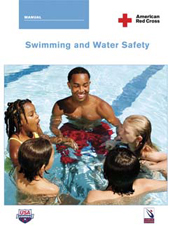
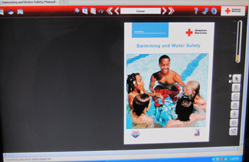
(The American Red Cross Swimming and Water Safety Manual had no index, so I wrote one: Swimming and Water Safety 2009 index).
The Cooper 12 minute swim test, which we do in my higher level swim classes, is on page 192, where it says “The 12-minute swimming test, devised by Kenneth Cooper, M.D., is an easy, inexpensive way for men and women of all ages to test their aerobic capacity (oxygen consumption) and to chart their fitness program.”
How can I tell if I’m a good swimmer? has more tests
Or should we call that page, how can I tell if I’m a fast swimmer?
In 1906 H. Jamison “Jam” Handy
experimented with putting his face in the water and invented modern freestyle breathing,
according to the International Swimming Hall of Fame:
“Handy is responsible for modern freestyle breathing, and the body position made possible by modern breathing. He invented the legless crawl for distance swimmers, the 2 or 4 beat “pause that refreshes” for middle distance, and lines on the bottom of the pool for sprinters to keep their heads down and see where they are going. He was the first swimmer to use the alternating arm stroke in backstroke and the first swimmer to narrow the kick and change the timing in breaststroke.
Handy won national championships in all 3 strokes before 1907 and then came on much later as a pioneer in using film for underwater stroke correction and technique analysis. He made two Olympic teams 20 years apart, 1904 (swimming) and 1924 (water polo), yet by his own admission, had very little talent. “My records didn’t last long,” he says, “because I had to win each time with some new invention. As soon as those bigger and faster fish got on to the change, I had to be satisfied with second place or try something else.”
He developed his new ideas while practicing at 3 a.m. after work. He could work in secret and may have even drained the pool to paint a line on the bottom before a big event.
Clarence Pinkston of the Detroit Athletic Club said that in preparing for a race against a famous competitor:
“It was then that Jam used his genius for analysis to figure out a method that would make the current crawl stroke more efficient. At that time the champs breathed by holding their heads up facing straight forward — a few swung their heads back and forth, from side to side. Jam worked in secret for six months on his idea of exhaling under water as the head was turned to the side for a breath coordinated with the arm pull. When he faced Daniels for the 1906 National AAU 800 championship, no one anyplace in the world had seen the crawl stroke as we all know it now, and Mr. Daniels saw very little of Jam Handy as he walked away with the championship easily. Within a year every top notch swimmer in the country copied Jam’s revolutionary idea.”
See more History of Swimming.


